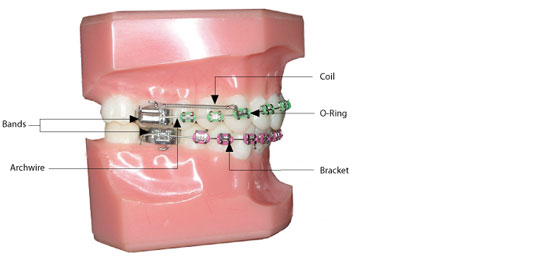
How do braces move and straighten teeth? There are many important aspects to braces. We’ll look at the tools and the process.
First, the stuff that goes in your mouth: the tools.

Most people are very familiar with the first two components of braces, the bracket and the archwire, because these are usually what you can see when someone with braces smiles.
Brackets can be made of metal or ceramic, and a bracket is attached to each tooth with a small dab of bonding material during your first visit.
An Archwire is a thin metal wire that runs from bracket to bracket and puts pressure on the teeth – sometimes the pressure you need is up or down, sometimes it’s side to side.
The Archwire is held to the brackets with elastic rings, sometimes called “o-rings” or “donuts.” The real names for these rings are Elastic Ligatures. Guess what? You can choose what color o-rings you want to customize your smile - check out the Martin Orthodontics Style Center.
Bands are metal rings that are usually placed on back teeth to anchor the archwire and sometimes to attach springs.
There may be other materials and accessories used for your braces, depending on your case. These may include tubes, hooks, loops, rubber bands, springs, steel ties, and headgear. Each case is different, and Dr. Martin will keep you informed on what’s going on in your mouth every step of the way.
Okay, so how does all this stuff actually move the teeth?
When Dr. Martin attaches the brackets, archwires and other orthodontic material in your mouth, he’s beginning to build your new smile. Sometimes, your teeth need to move up or down, and sometimes they need to be spaced differently from side to side. That’s what all these tools are for.
Since the brackets are affixed to your teeth, the teeth move gradually when the arch wire puts pressure on the brackets. The archwire is very important, since your teeth will eventually follow the shape of the archwire. Sometimes, some of the other materials, like springs or rubber bands are used to add more movement in a specific direction, especially side to side.
When braces put pressure on your teeth, your teeth are actually getting loosened and
repositioned where they’re supposed to be. Once they’re in the right spots, the braces hold them there, and bone tissue in your jaw grows back in and your new smile stays in place.
Technically, this is a biomechanical process called bone remodeling. It’s pretty serious stuff - that’s why Dr. Martin is a Doctor! It’s also why orthodontists typically have 3 additional years of education and training, compared with regular dentists. It usually takes about three days for the bone remodeling process to start, then about three months to grow new bone and then about a year or less to stabilize the results. That’s why your braces stay on for so long, and why you’re strongly encouraged to wear a retainer…to keep your beautiful new smile in place and healthy!